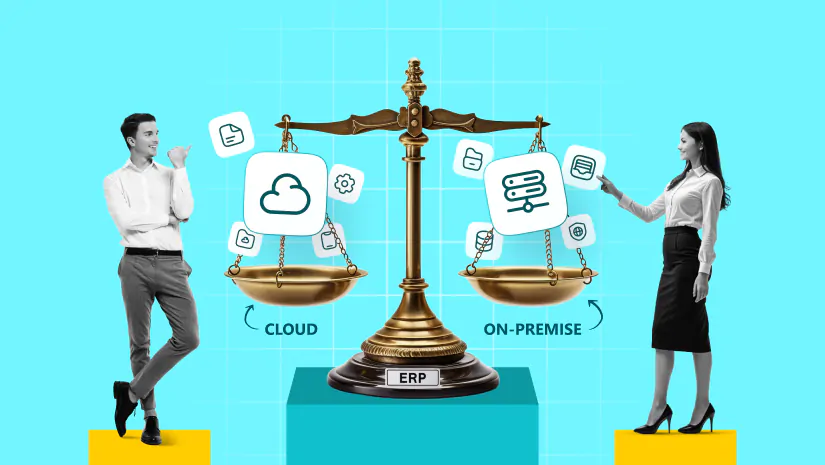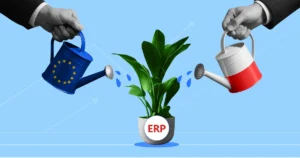In today’s fast-paced business environment, organizations across industries — whether private companies, government institutions, or non-profits — need robust Enterprise Resource Planning (ERP) systems. These systems have become essential, enabling businesses to streamline operations, gain real-time insights, and make informed decisions that drive growth and efficiency. The key decision isn’t whether an ERP system is necessary, but rather which type — cloud-based or on-premises — aligns best with the company’s strategic goals.
The Rise of Cloud and On-Premises ERP: Choosing the Right Path
Cloud ERP solutions have gained significant momentum in recent years, offering businesses the flexibility to access data and applications from anywhere. These solutions integrate critical business processes such as financial management, supply chain operations, and more, while ensuring scalability. Cloud ERP allows companies to automate routine tasks, reduce IT overhead, and adapt quickly to shifting market demands. According to Gartner, by 2025, an estimated 85% of all ERP systems will be cloud-based, up from just 35% in 2020.
Regional adoption rates of cloud ERP vary:
- North America leads in cloud ERP adoption, with 94% of U.S. enterprise infrastructure decision-makers utilizing at least one form of cloud deployment, according to Forrester.
- Asia-Pacific hosts 37% of the world’s cloud data centers, indicating a significant shift toward cloud-based solutions.
- Europe is also adopting cloud ERP at a rapid pace, in line with modernization efforts and cloud-native business strategies.
Despite this growing trend, many businesses continue to prefer on-premises ERP solutions due to industry-specific regulatory requirements. Sectors such as manufacturing, government, and finance often need full control over data storage and compliance, making on-premises ERP a practical choice. Microsoft Dynamics 365 Business Central (formerly Dynamics NAV) remains a top ERP platform, offering both cloud and on-premises deployment options to meet diverse business needs. While cloud ERP offers flexibility and scalability, on-premises solutions are essential in industries that require strict data governance.
However, for SMART business, the number of on-premises installations has been continuously decreasing over the past year. In 2024, not more than 6% of implementations were on-premises, highlighting the company’s strategic shift towards cloud-based ERP solutions in response to market demand and efficiency considerations.
The Future of ERP: Cloud-Only Solutions
A significant shift is underway within ERP providers, with major vendors like Microsoft moving toward cloud-exclusive offerings. Microsoft recently announced that Business Central BC25 will be the last version supporting direct upgrades from BC14-24. Starting with BC26, which is scheduled for release in early April 2025, additional steps will be required for upgrades, marking a stronger commitment to cloud solutions.
For users of Microsoft Dynamics 365 Business Central versions prior to BC25, upgrading will become more resource-intensive. With the introduction of additional upgrade steps, the process will take more time, resources, and money. A one-step upgrade is typically faster, simpler, and less expensive, but an additional step means a broader project scope, increasing time and costs. Furthermore, Microsoft’s stricter versioning requirements may complicate support and compatibility for older versions, especially for companies integrating BC with other Microsoft business applications or third-party systems.
Users can upgrade to BC25 before BC26 to maintain the one-step upgrade process, ensuring smoother, faster, and cost-effective future updates. This minimizes risks, reduces IT workload and preserves customizations, saving time and resources.
Key Factors Influencing ERP Selection
- Cost Considerations
- Cloud ERP: Operates on a subscription-based model with a unified licensing approach for both SaaS and on-premises. While it reduces upfront capital expenditure, costs may vary depending on system load, database size, and additional licensing requirements (e.g., LS Central in SaaS or extra storage for large databases).
- On-Premises ERP: Involves not only software licensing but also operational costs such as OS and SQL licenses, server rental, and maintenance. While long-term expenses depend on infrastructure efficiency, for resource-intensive systems or large databases, on-premises can sometimes be more cost-effective than SaaS.
- IT Infrastructure and Maintenance
- Cloud ERP: The vendor manages updates, security, and maintenance, reducing the load on internal IT teams.
- On-Premises ERP: Requires an in-house IT team for software updates, security, and hardware maintenance.
- Security and Compliance
- Cloud ERP: Security is handled by the provider with industry-standard certifications, although concerns about third-party data storage remain.
- On-Premises ERP: Provides greater control over security and compliance, ideal for highly regulated industries.
- Scalability and Accessibility
- Cloud ERP: Easily scalable and accessible from anywhere with an internet connection.
- On-Premises ERP: Scaling requires additional hardware investment, and remote access can be more limited.
- Implementation Speed
- Cloud ERP: Typically faster to deploy since it doesn’t require hardware setup.
- On-Premises ERP: Longer deployment times due to infrastructure and software configuration.
- Business Continuity and Disaster Recovery
- Cloud ERP: Offers built-in disaster recovery and backup capabilities.
- On-Premises ERP: Requires manual backup strategies, increasing data loss risks.
Making the Right Choice
Choosing between cloud and on-premises ERP depends on a company’s specific needs, industry requirements, and long-term IT strategy. While cloud ERP provides scalability, lower maintenance, and better accessibility, on-premises ERP offers greater control over security and customization. With the increasing dominance of cloud-based ERP solutions, organizations must evaluate the long-term benefits of adopting SaaS models to stay competitive and future-proof their operations.


